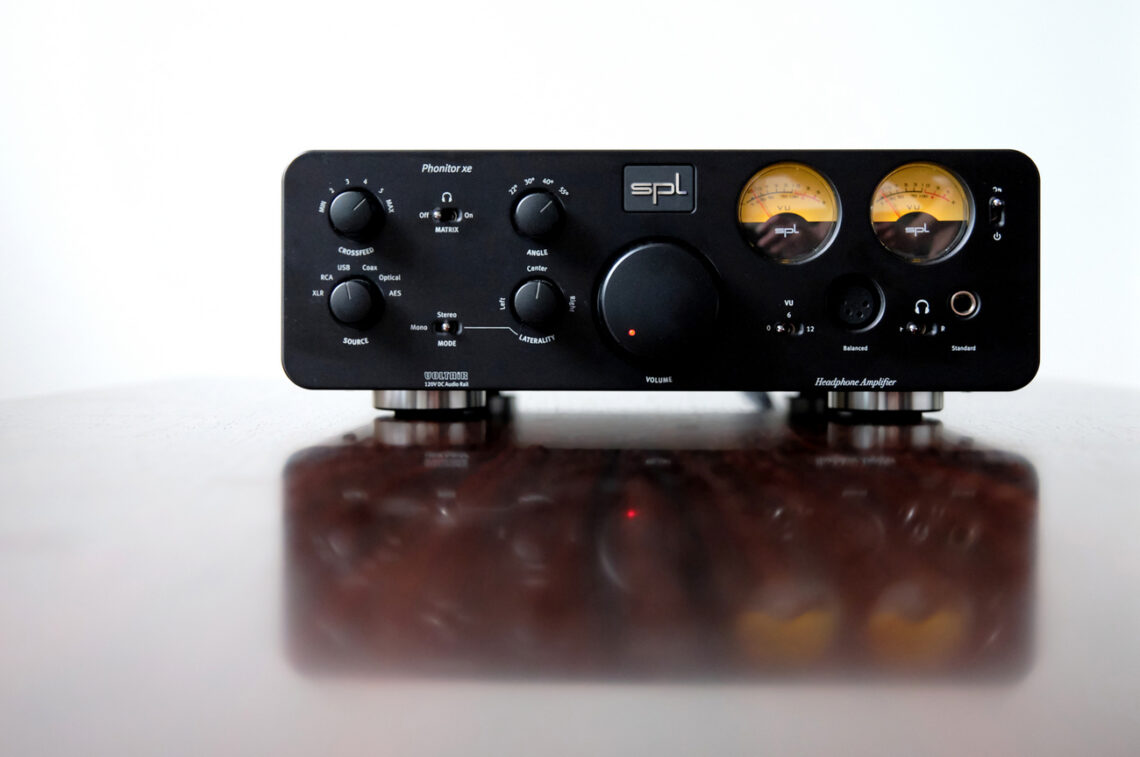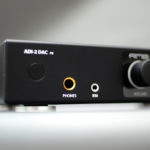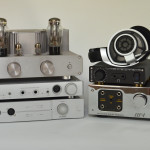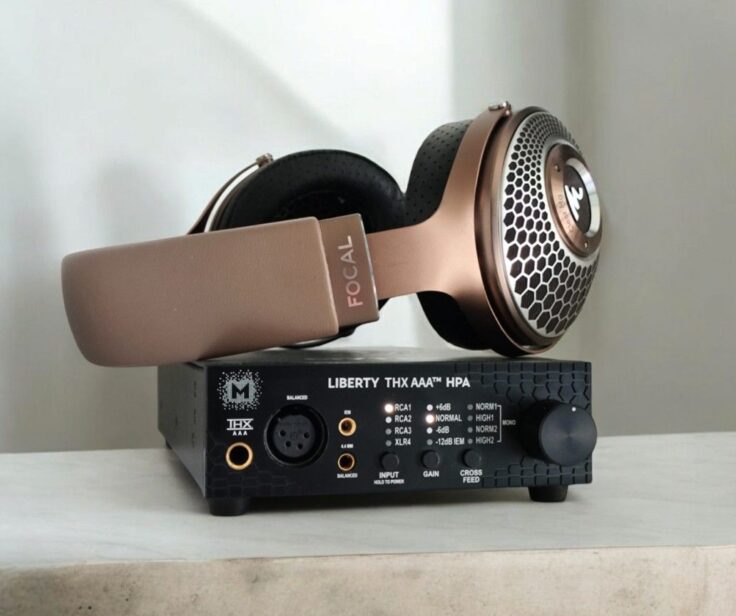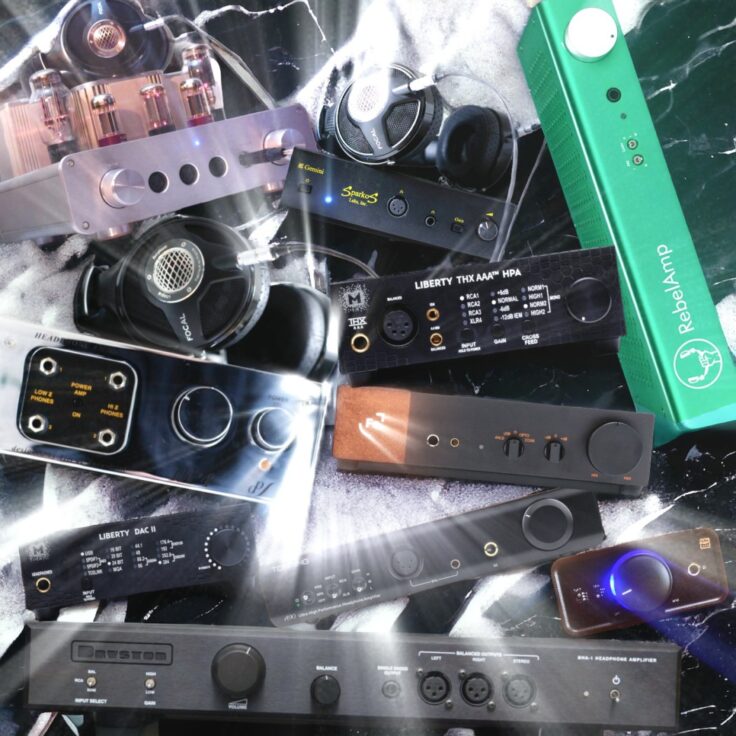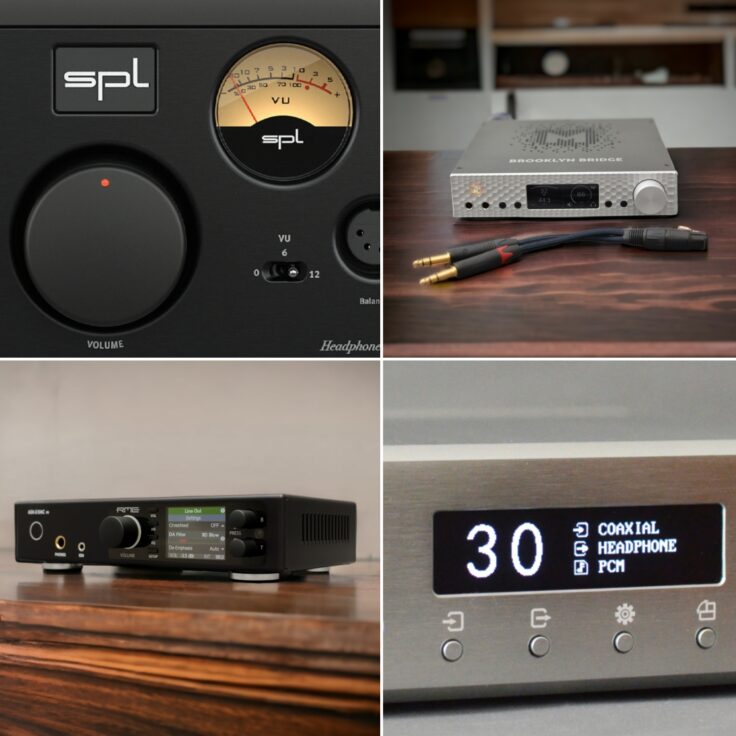(….and in some ways a review of the Phonitor x and e )
The SPL Phonitor xe houses the same powerful balanced headphone amplifier as the Phonitor x and Phonitor e. It has several unusual features like a unique crossfeed-angle matrix and both rear and front headphone outputs. The Phonitor xe is available with an optional high-end DAC. This piece of equipment is made with both the professional and the headphone aficionado in mind.
The original SPL Phonitor was launched more than a decade ago. It was targeted mainly at professionals that needed to mix their music with headphones, utilizing advanced cross-feed technology intended to make it easier to hear how the mix would sound on speakers.
SPL has upped their game in recent years with a selection of no less than four versions of the Phonitor. They basically share the same standard headphone amplifier section, but vary in terms of connectivity options, functionality and (in the case of the Phonitor 2) output power.
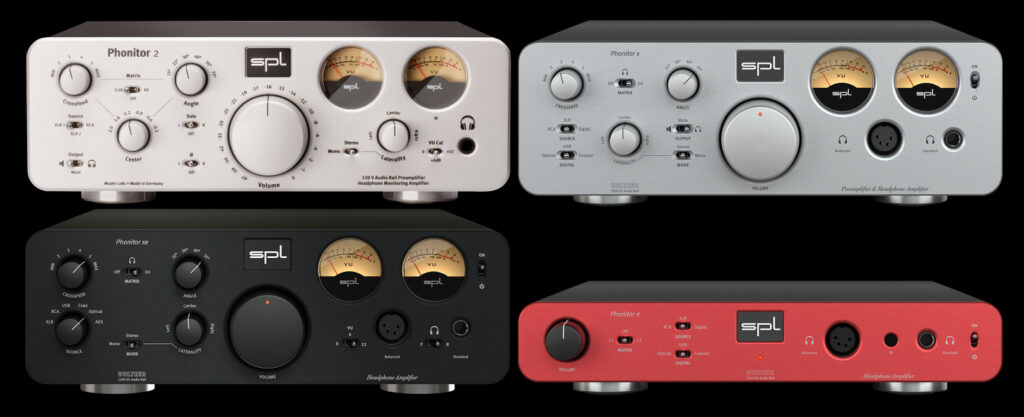
Meet the Family: Phonitor 2, Phonitor x, Phonitor xe and Phonitor e
Essentially, the four Phonitor siblings fall into two categories. The Phonitor 2, which is the new version of the original Phonitor, and Phonitor x are pre-amps and headphone amplifiers. The Phonitor e and xe are dedicated headphone amplifiers. The Phonitor 2 is analog only, the other three can be had with a built-in DAC. All have different options for controlling the cross-feed matrix and other functions. This all might sound a bit confusing. Fortunately, SPL has made a helpful chart comparing the models and clarifying the differences (link).
Powering Headphones
With regards to headphone performance, there is one important difference between the Phonitor 2 and the rest. The Phonitor x, xe, and e have both balanced and unbalanced outputs. The Phonitor 2 is unbalanced output only. This is quite a big deal for demanding headphones. The balanced output is roughly twice as powerful because it uses a separate power amplifier for each channel.
Other than the Phonitor 2´s lack of a balanced output, there are, according to SPL, no significant differences between the four models that affect the headphone amplifiers’ performance. All the unbalanced outputs have identical measurements.
In other words the un-balanced headphone amplifier performance of all the four Phonitors (Phonitor x, Phonitor xe, Phonitor e, and Phonitor 2) will be identical, and the balanced headphone amplifier performance of the ones with a balanced output (x, xe, and e) will be identical.
The four Phonitor siblings have different implementations and adjustment possibilities of SPL’s cross-feed “Phonitor Matrix” technology. It is, simply put, a way of adjusting the stereo image to be more “speaker-like”. Basically, it “leaks” sound between the channels with various amounts of delay, with the effect of making the listener experience less of an “inside your head” soundstage. It also helps when mixing audio on headphones because you get a better sense of how the music will sound with speakers.
The Phonitor 2 offers the most advanced Matrix options because it is targeted at music production. The other amps have less advanced Matrix options (in various degrees), because they are targeted at music playback. However, they still offer a lot more than a standard headphone amplifier.
The DAC768 and DAC768xs
If you want a built-in DAC for your Phonitor, the Phonitor xe comes with SPL´s DAC768, the Phonitor x, and Phonitor e are equipped with the “light-version” DAC768xs. Both DACs are built around the same “Velvetsound” AK4490EQ DAC chip and have an identical digital stage. They handle the same formats and sample rates.
The most visible difference is that the 768xs lacks the AES input, but the most significant difference lies in the analog stage that follows the DAC chip. The “maxed out version” DAC 768 has an analog stage that is equipped with SPL’s 120V Rail Amplifier, SPL’s “Profi-series” components, and Styroflex capacitors. The analog section of the DAC768xs (the “light version”) is less sophisticated, and also less power consuming.
The latter is an important reason why only the xe comes with the best DAC. According to SPL, the DAC768 is drawing too much power to be used with the Phonitor e and x. The Phonitor e has a smaller power supply than the Phonitor xe, whilst the Phonitor x has the same power supply, but needs that extra power for the preamplifier output. I guess SPL could have chosen to make it impossible to use the pre-amp and the headphone outputs at the same time, but they have not done that. It is also a matter of real estate: Previously, the e and the x came with a different DAC module called the DAC192, so the 768xs DAC is designed to take its place. The lack of an AES input is also a matter of saving real estate.
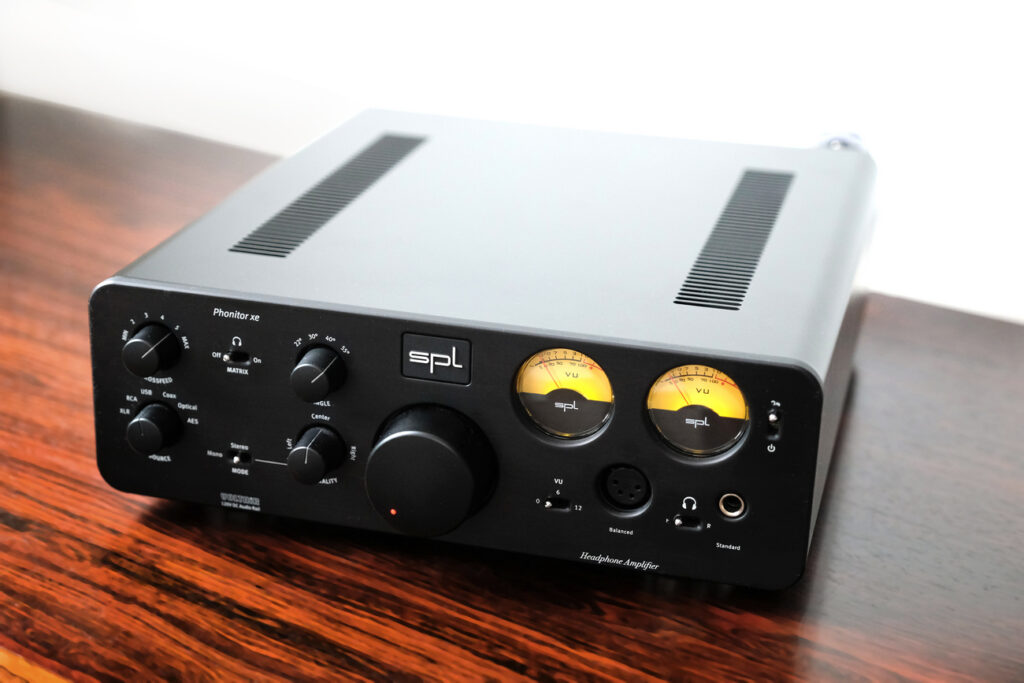
Design and Functionality
The Phonitor is quite large, measuring 28 cm wide and 33 cm deep. It has a gorgeous front panel that surely appeals to the audio geeks among us with lovely VU-meters and great-looking knobs and switches. It feels very sturdy. The only negative I can say about it is that some of the text markings beside the most used switches wore off after only a few months of use.
Inputs, Outputs and Buttons
The Phonitor xe has no analog outputs, and can only be used as a dedicated headphone amplifier either with analog sources or the optional internal DAC. The optional DAC has four inputs: AES, optical, coax, and USB.
The Phonitor xe has the rare trait of having no lessthan 4 (four!) headphone outputs: There is a 6.35 mm TRS and a 4-pin XLR in the front and, more remarkably so, a 6.35 mm TRS and a 4-pin XLR on the back. This is great for more permanent rigs. It can be very nice to have your favorite headphone permanently plugged into the back to avoid cable clutter. You select whether to listen to the front or back outputs with a switch on the front.
Since the TRS plug overrides the XLR, you cannot drive more than one headphone at the same time, and as long as there is a headphone plugged into the TRS output, the corresponding XLR will be muted. What is plugged into the back does not affect the front and vice versa. Personally, I would find it more useful to have a manual switch for the XLR/TRS output rather than a built-in automatic TRS switch. But still, you can have two headphones plugged into the amp (one in the front, one in the back) and alternate between them with a switch. That is pretty neat.
In addition to the obvious input selection, volume control, and the above mentioned “front/back” button, you also have a “channel balance adjustment/laterality” knob with an accompanying “mono/stereo/balance” hard switch, as well as a sensitivity switch for the VU meters and of course the Phonitor Matrix knobs.
The analog volume control knob is worth a comment in itself. It is big and has a great “knob feel” and a small built-in LED indicator. It is stepless and very smooth feeling, therefore it is easy to adjust the volume – unlike with many digitally controlled variants, where you have to spin forever to adjust the volume significantly. It is also remote controllable. There is no remote included, but you can program the Phonitor to accept any remote control.
Finally, there are two dip switches located in a hole in the bottom plate of the Phonitor. One is to increase the output level of the headphone outputs, another is to alter the input sensitivity of the analog RCA inputs from -10dBV (HiFi level) to 0dBu (Studio level). Both are of course a nice option to have, but the location of this switch almost couldn’t be more awkward. But hey, at least you don’t have to open the amp.
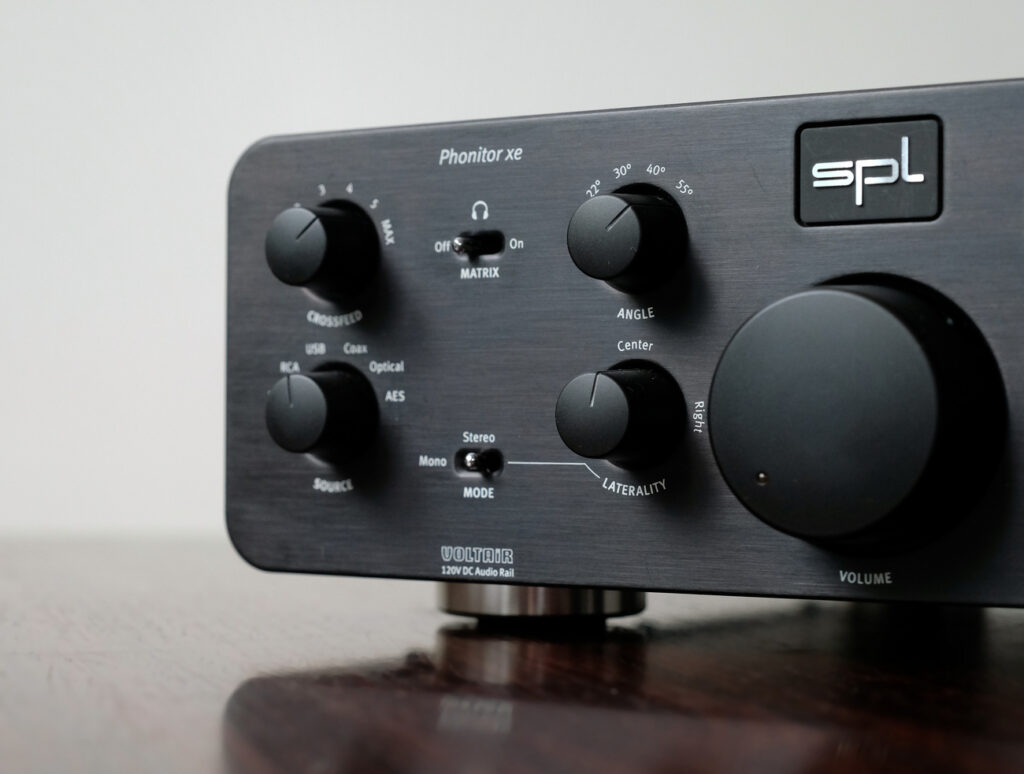
The Phonitor xe’s Matrix
When it comes to the Phonitor Matrix, there are plenty of adjustment possibilities. You can adjust the amount of crossfeed in 6 steps and the simulated angle in 4 steps. I let SPL elaborate on what these controls are intended to do:
“The Crossfeed switch allows you to adjust the frequency-dependent crossfeed simulation of both channels by adjustments of interaural level difference … One can compare variations in crossfeed values as approximating the influence of different room sizes and characteristics on a given loudspeaker setup. …. Crossfeed interacts with the Angle value to simulate the width of a stereo image.
The Angle switch provides for frequency-dependent simulation of your stereo image width by adjustments of interaural time difference. This influences the moment in time at which a signal’s waveform arrives at the ear and corresponds to a particular variation in the angle of an actual loudspeaker pair. The time constants of the interaural time differences between the left and right channels occur within a range of 90 to 635 microseconds….”.
After reading SPL’s description, I honestly expected a bit more dramatic effect than I experienced. The Phonitor Matrix does not make your headphones sound like speakers, either is it a replacement for binaural recordings or fully-fledged surround simulators like the “Smyth Realiser”.
However, the effect is pleasing, and with music with a very wide mix, it really saves the day. I have previously owned the Grace M902 and Lavry DA11, and the Phonitor definitely is better than the crossfeed options they offered. They felt a bit destructive on the sound quality; I do not get that feeling with the Phonitor.
I must admit I did not use the crossfeed too much, mainly because I spent so much time comparing the Phonitor to other amplifiers. I did, however, find myself enjoying the Phonitor Matrix and could easily be accustomed to using it on a regular basis.
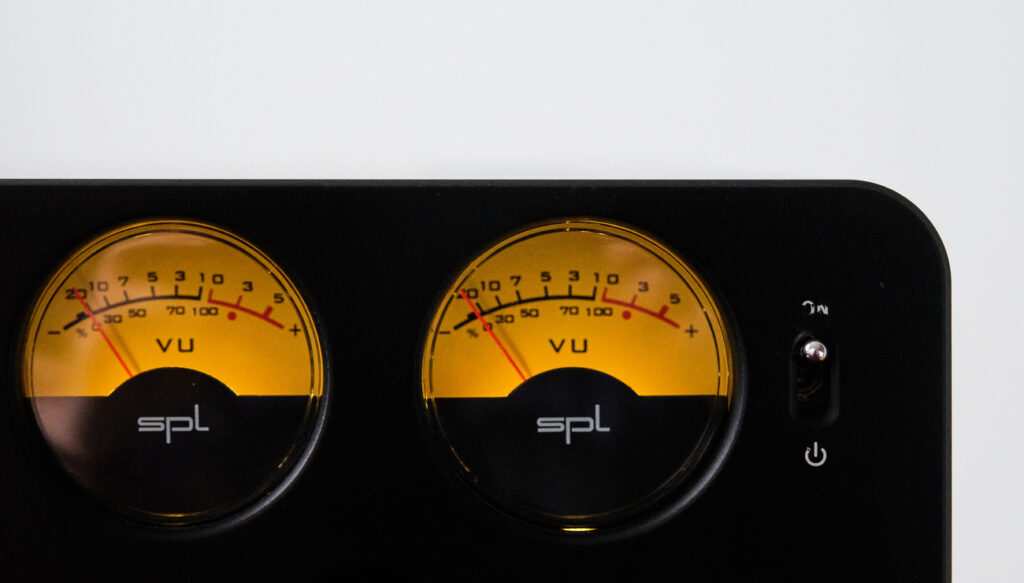
Testing the Phonitor xe
Since it has the best DAC option as well as the balanced headphone output, the Phonitor xe, which is the test subject in this review, can be considered SPL’s flagship DAC/Amp option.
I will, however, not only test the Phonitor xe as a DAC/Amp, but will also test it as a standalone amplifier. This implies that this review is also. in part, a review of the Phonitor e and the Phonitor x – as long as we keep it to analog headphone performance. I have indicated when I use the unbalanced and the balanced outputs, therefore, as long as we keep to the unbalanced headphone output, the results are also relevant for the headphone performance of the (un-balanced only) Phonitor 2.
Usually, I like to closely incorporate the music I listen to in my text. However, to keep this review from becoming absurdly long, I kept the descriptions more general this time. I put together a playlist of the most used tracks that can be found after the final conclusion.
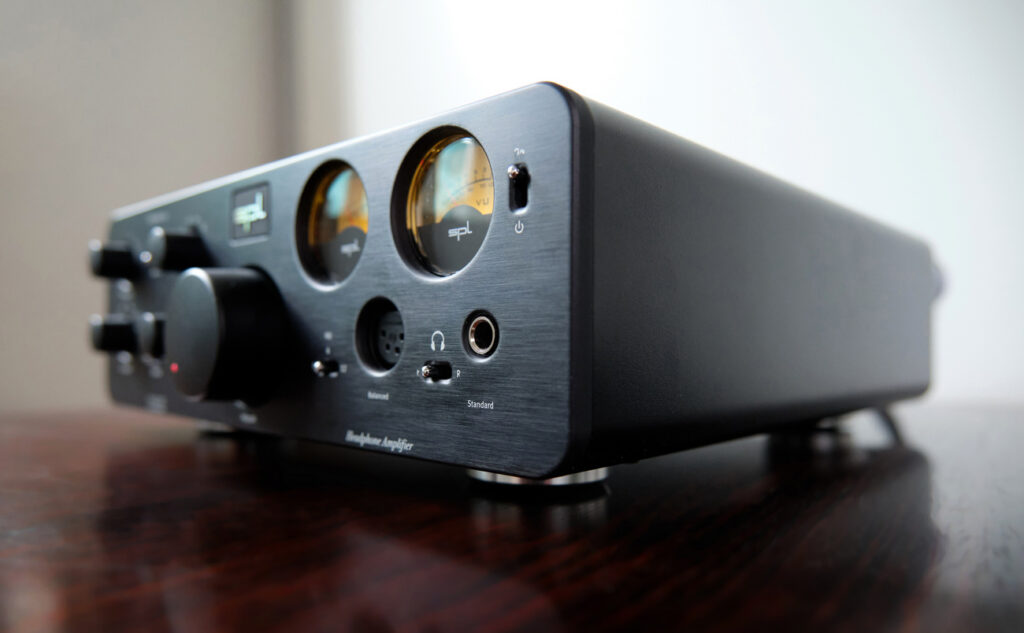
THE PHONITOR xe COMPARED TO OTHER DAC/AMPS
SPL Phonitor xe vs RME ADI-2 FS (v2)
The RME ADI-2 was recently updated with a new DAC chip in a rather silent upgrade. RME does not themselves use the “v2” in the name. I find it safe to assume that the headphone performance of the new version is not very different from the first.
In my RME ADI-2 (v1) review, I compared the Phonitor to the ADI-2 using mostly the unbalanced output. I found them often to be comparable, although I tended to prefer the Phonitors slightly warmer presentation. This time, I will use the RME ADI-2 (v2) and will only compare it to the more powerful balanced output the Phonitor xe.
Audeze LCD-3: The Phonitor has better dynamics and more headroom; it also feels a bit warmer and fuller in the midrange.
Sennheiser HD700: The Phonitor drives the HD700 beautifully. Spacious and dynamic, with a nice hint of warmth. The RME does a good job, but the Phonitor is, simply put, more organic sounding.
Sennheiser HD800: Also here, the Phonitor does a better job, with a bigger margin than above. The RME is good but sounds less coherent, less organic, and a bit more brittle.
Further, the Shure SRH-1840, Beyerdynamic T1mk2, and Hifiman HE1000v2 all sounded better with the Phonitor in unbalanced mode, and the difference is even more significant with the balanced output.
All in all, given that you utilize the balanced outputs, the Phonitor xe is indeed several steps up as a DAC/Amp compared to the already capable RME ADI-2.
Phonitor xe vs Burson Conductor 3R
In this comparison, I use the Internal DACs of both units. The Conductor 3R has an unbalanced output only, but I compare it to both the outputs of the Phonitor.
HD800 Unbalanced, they are very similar, but the Phonitor is slightly more present in the midrange. The Burson might have the best bass performance and offers a slightly more open soundstage, maybe a bit more refined sounding. With the Phonitor balanced, it tightens up slightly and feels more transparent, still retaining that extra midrange presence. Basically, in unbalanced mode, they perform very evenly, but when using the XLR output, the Phonitor is the better amp.
Beyerdynamic T1 With the balanced output, the Phonitor is the better sounding with the T1. The Burson gets a tad dry sounding, not as open, detailed, and organic. It is good, but the Phonitor is better. Moving over to the less powerful unbalanced output of the Phonitor, it evens out.
Shure SRH-1840 The Phonitor is an excellent match for the SRH-1840. With its balanced output, it clearly gets the upper hand due to better dynamics, clarity, and precision. Going unbalanced, they get a lot more ven.
Hifiman HE1000 mk2 Both sound good, but it must be said that few amps do these headphones full justice, and the balanced outputs of the Phonitor is closer to releasing the HE1000´s full potential than the Burson. Unbalanced, they are on a similar level, but going balanced, the Phonitor definitely gets closer to showing what these headphones can do when properly matched.
LCD-3 Both amps are great. Compared to the Phonitors unbalanced output, I prefer the Burson. It’s slightly tighter, clearer, and crisper. Using the balanced XLR output of the Phonitor, however, the table flips, and the Phonitor gets slightly tighter and offers a bit more headroom than the Burson.
Fostex TH-900 (unbalanced only) The Burson, even in low power mode, is simply too noisy for these extremely sensitive (for full size) headphones. The Phonitor is so quiet even in High Power mode that I don’t even bother to try it in low mode, at least for now – given the extremely awkwardly positioned switch.
Hifiman HE-6 Even though the extremely hard to drive HE-6 is somewhat of a curiosity, it is always interesting to see how an amplifier handles them. Both these amps handle the HE-6 totally acceptably. These have enough power to make the HE-6 sound good. However, neither quite matches the level of dynamics and PRaT you can get with a good speaker amp. They are in the same territory as the standard edition Audio-gd Master 9, which I consider the reference for “acceptable” performance. The Phonitor has a bit more headroom and dynamics than the Burson.
LCD-X and Focal Elear (unbalanced only) The Phonitor has a slightly meatier presentation, and to me, it sounds delicious. The Conductor is not sterile or clinical by any means, but feels a bit more polite. It has great detail and spaciousness but not the same grunty feeling.
Concluding, both these amps are great. With the unbalanced outputs, it is often a toss-up. The Phonitor is a bit fuller and meatier sounding, the Burson a bit more refined and polite. Going balanced, however, the Phonitor clears up and generally offers more dynamics and clarity – while still retaining a hint of that “meat to the bone” fullness.
Phonitor xe vs Mytek Bridge/Mytek DAC+
The Mytek Bridge is simply a Mytek DAC+ with a network input. They both can be run in balanced mode. It requires an adapter that uses the dual TRS output and combines them so that each power one channel only. In this comparison, I compare the Phonitor´s unbalanced output to the Mytek’s unbalanced output and the Phonitor´s balanced output to the Mytek with the balanced adapter. I use the internal DACs.
HD800 Both DAC/amps do a very good job. Unbalanced, the Mytek is a bit sharper sounding. The Phonitor has more meat and body to its presentation. Going balanced, both tightens up and gets better, with a clearer and more articulated sound presentation. The Mytek is still a bit drier and less organic sounding, though, and I still prefer the Phonitor.
Beyerdynamic T1 mk2 Listening to Leonard Cohen’s “The Hills”, in the more powerful balanced configuration, the Phonitor has more midrange body. Generally, the Mytek feels a bit sharper, the Phonitor keeps that treble softer and more pleasant to the ear. Both do a great job, but I prefer the Phonitor. Unbalanced, both amps sound a bit softer and slightly muffled. They are still great, though, and I even might prefer the Mytek unbalanced, it helps soften the treble “bite” of the T1 a bit.
Shure SRH-1840 With the balanced output, they both are wonderful with the SRH-1840; detailed and dynamic. The Phonitor offers slightly more body, especially in the midrange, but they are not very different. Unbalanced, I basically find that the difference between them remains the same, but both loose slightly in terms of dynamics and headroom.
Hifiman HE1000mk2 Unbalanced, they perform similarly decently, but not optimally. The Phonitor is a bit warmer and thicker sounding. Moving on to the balanced output, the Phonitor stays with a slight extra dose of warmth, but both are definitely more in control of the quite demanding HE1000mk2.
Audeze LCD-3 Balanced, both are clear and crisp, but the Phonitor has that extra dose of midrange presence. It is just sweeter sounding, without losing any perceived detail. Going unbalanced, they both lose a bit headroom, but the relative difference remains the same.
Concluding, these are both great DAC/Amps. Generally, unbalanced, the Mytek Bridge/DAC+is a bit crisper and sharper sounding, the Phonitor a bit warmer and cozier sounding. When going balanced, they both seem to get more in control of the headphones: The Phonitor becomes cleaner and crisper, the Mytek a bit less sharp around the edges and more organic sounding. There is no doubt that the balanced modes of these amps make a big difference.
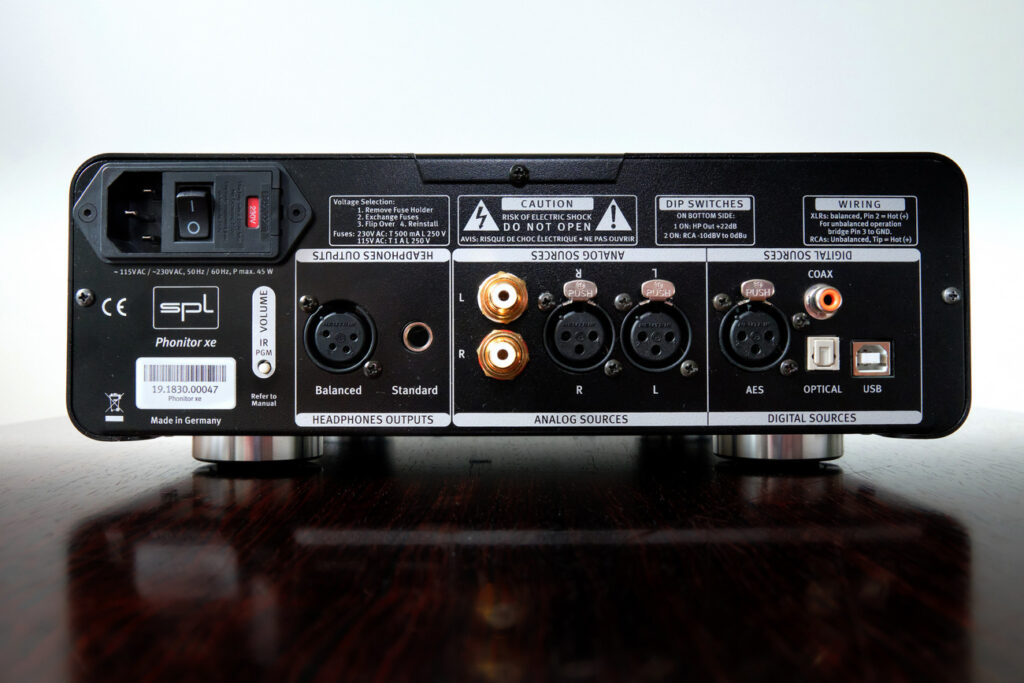
THE PHONITOR DAC768 COMPARED
Since there is no way to listen to the built-in DAC768 other than through the Phonitor xe itself, that’s the way I compared it to other DACs. I compared it to the DACs of the above units: The Burson Conductor 3R, the RME ADI-2, and the Mytek Bridge.
Neither with the Burson, the RME ADI-2, or the Mytek Bridge, do I find that there is anything exceptionally noteworthy to write about. There are subtle differences to be heard if you listen for it on certain passages on select tracks, but they are very small. Maybe the RME is a tad better, and the Mytek seems to be ever so slightly more transparent sometimes, but mostly, none of these alternative DACs seems to make much of a difference compared to the built-in DAC. In other words, SPL´s DAC768 is pretty darn good, and I wouldn’t feel the need to upgrade it even with my most transparent headphones.
I did not play around much with various digital sources on the Phonitor. My experience is limited to using the Allo DigiOne and USB Bridge digital transports as sources, playing Roon software with both Tidal and local FLAC files of various formats. There was no discernible difference between the coax and the USB input with that setup.
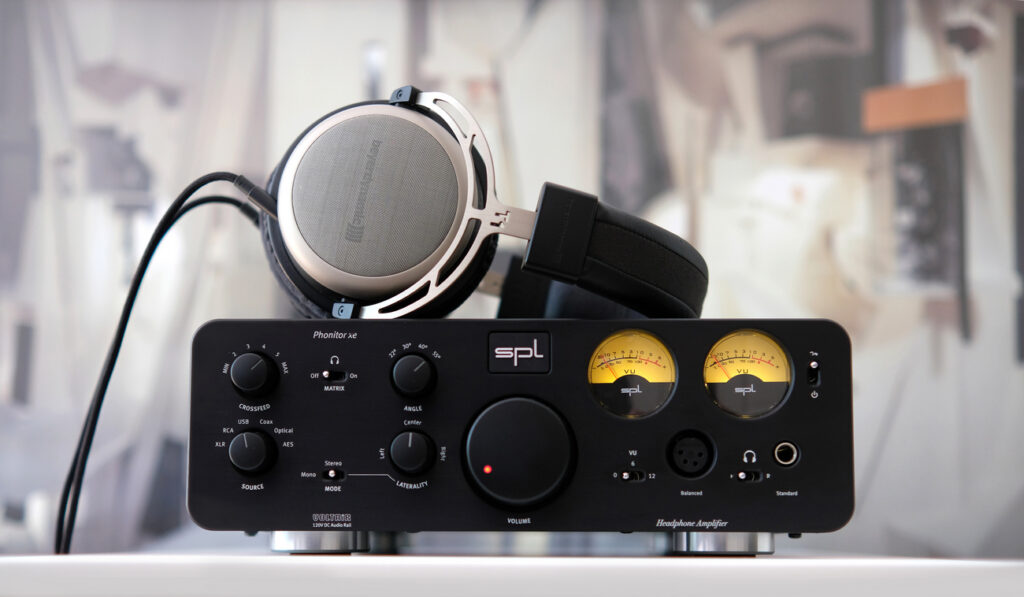
AMPLIFIER COMPARISONS
SPL Phonitor xe vs Violectric V200
Source for both: The Violectric V800 DAC
I start out with the Audeze LCD-3. The tender improvisations that constitutes the track “Fluorecent” by Dans Les Arbres is a delicious collection of sounds. The Phonitor delivers a full, organic and spacious experience. It feels warm and welcoming, spacious and nuanced. Even though the V200 is a great amp, it somehow sounds flatter and less organic. There is a better sense of flow, of breath, of timbre with the Phonitor. The Phonitor sounds more at ease, more natural and, in lack of a more precise word: free.
Moving through my playlist, my first impressions are mirrored, The Phonitor is more organic, more relaxed, more spacious and natural sounding. In other words, the Audeze LCD-3 sounds sweeter and even more delicious with the Phonitor than with the already good V200.
I immediately fell in love with the way the Phonitor drives the Sennheiser HD800. Most of what I said about the difference between these amps with the LCD-3 applies to the HD800 too. The sometimes quite fatiguing HD800 can spend hours and hours on my head with the Phonitor.
Moving on to the Hifiman HE1000v2, the Phonitor again has a much warmer and more organic sounding presentation, yet retaining detail and transparency.
SPL Phonitor vs Beyerdynamic A1
Source for both: Violectric V800 DAC
Both the Sennheiser HD800 and the Beyerdynamic T1 mk2 sound great with the “high impedance specialist” amplifier A1, which is the previous version of the Beyerdynamic A2. However, the Phonitor sounds even a bit more open and organic.
Further, the A1 is no slouch with the Sennheiser HD650, but to my surprise, the Phonitor is a lot better. The difference is actually bigger than with the HD800 and T1. The HD650 is quite a lot warmer and more organic with the Phonitor compared to the A1, which sounds dry and distanced in comparison.
SPL Phonitor xe vs Questyle CMA800R
Source for both: The Violectric V800 DAC. The Questyle is unbalanced output only.
With the Sennheiser HD800 (balanced), these amps are very similar. Maybe the Phonitor has a tiny tad more warmth and body; the Questyle feels slightly drier. But both are on the warm side of clinical, both sound organic and natural. The Questyle certainly is one of the better amps out there for the HD800, and the Phonitor xe is certainly not inferior.
With the Audeze LCD-X (unbalanced), I find the two amps very similar too. The Beyerdynamic T1 mk2 is very nice with both amps, but the Phonitor feels even a bit more rounded, organic, and natural feeling, yet full of detail and dynamics. Finally, the Hifiman HE1000mk2 might also sound slightly better with the Phonitor.
With the Sennheiser HD660S (unbalanced only) the Phonitor is more dynamic and spacious. Both amps are both good, but with REM´s “How the west was won..” the Phonitor is truly glorious with the HD660S. It has more low end grunt and punch. Generally, vocals are bolder, things stand out more with the Phonitor. I find similar differences with the Beyerdynamic DT1770PRO.
Concluding, these amps have much in common. I tend to slightly favor the Phonitor. They have a similar sound signature; neutral, but slightly warm and organic.
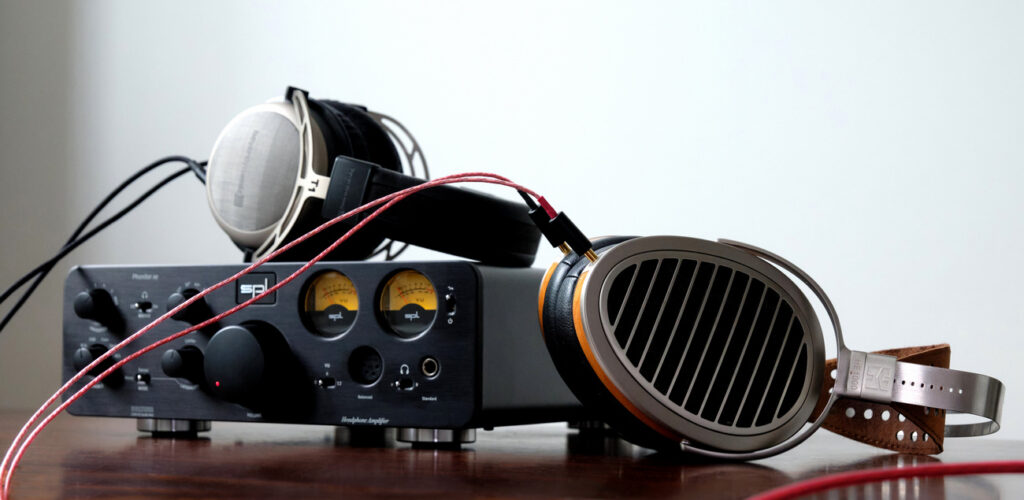
SPL Phonitor xe vs Bryston BHA-1
Source for both: Mytek Brooklyn Bridge
The Phonitor has performed better than many amps tested above with Hifiman HE1000v2. However, this headphone is not an easy beast to drive optimally, and it becomes apparent that the BHA-1 has a tighter grip on the HE1000v2. It gives it more headroom, a bit more detail, and it is tighter and more spacious. With “Voodoo” by Sonny Clark Memorial Quartet, the percussion is even more snappy and instruments even better defined in space.
I might go as far as to say that the Bryston elevates the HE1000v2 to a higher level than most amps, including the Phonitor. Don´t get me wrong: The HE100v2 sounds great on the Phonitor, but in direct comparison, the Bryston is more impressive.
Also, the Sennheiser HD800 gets more headroom with the Bryston, although the difference is not as big as with the HE1000v2. On the other hand, the Phonitor has a more velvet-like presentation of vocals, which is nice.
I continue with Beyerdynamic T1 mk2, Audeze LCD-3 and Focal Elear: All headphones reveal similar differences. The Bryston offers more headroom; it is tighter and more dynamic sounding. The Phonitor is certainly no slouch but falls slightly short in direct comparison. It does have a pleasing hint of smoothness to its tone.
All in all, I feel the Bryston offers more headroom and a tighter and even cleaner sound. Although I mostly prefer it over the Phonitor xe, the Phonitor is really close on the Bryston’s strong points, and has a hint of that “velvety tone” that the Bryston lacks.
SPL Phonitor xe vs Auralic Taurus
Source for both: Mytek Brooklyn Bridge
With the Focal Elear (unbalanced only) they both give plenty of headroom. The Phonitor feels nicer and more rounded in the high-end spectrum.
The two amps are doing a good and pretty similar job with the Sennheiser HD800. The Taurus offers slightly more headroom, but not as much as the Bryston BHA-1. The Phonitor is again a bit more velvety in the midrange.
The Phonitor is better, warmer sounding with the Beyerdynamic T1mk2. The treble is less aggressive, string instruments feel more natural. The Taurus gets a bit too bright and edgy sometimes, I never really found te T1 optimal with the Taurus.
The two amplifiers perform equally well with the Audeze LCD-3. With the Hifiman HE1000v2, the Taurus is better. It offers more headroom, snap, and speed, although not at the level of the Bryston BHA-1.
The first time I heard the Shure SRH-1840 was on the Taurus. I immediately felt I needed to own that headphone. However, the SRH-1840 sounds even more delicious with the Phonitor. It is most of all more dynamic. I honestly doubt the 1840 can get any better than with the Phonitor. I end up listening to music I haven’t enjoyed in a long time, Coldplay’s “Parachutes” sounds terrific.
SPL Phonitor xe vs Woo WA22
Source for both: Mytek Brooklyn Bridge. The WA22 is equipped with upgraded tubes
Unsurprisingly to me, the WA22 is better with the Hifiman HE1000v2, since I regard the WA22 to be a stellar match for this headphone.
I like the WA22 better with the Sennheiser HD800 too. It has more energy and feels more alive. It is like the details are popping out more. The drums have more edge, the strings of intense violins have more bite. I could also say that it feels more articulate. Also, the Audeze LCD-3 is a tad more lively with my WA22, but the difference is less than above.
With the Shure SRH-1840, the preference shifts. Even though the WA22 also here is a bit more upfront and energetic, it gets a bit shouty. I find the Phonitor to balance the sound perfectly. Also the Sennheiser HD700 sounds better with the Phonitor. It feels less strained, more at ease and natural.
All in all, these are both great amps. Mostly I preferred the mighty WA22 for its energy and articulation, but not always.
SPL Phonitor xe vs Audio-gd Master 9
Source for both: Mytek Brooklyn Bridge.
Not many headphone amplifiers can drive the Hifiman HE-6 close to its potential, and the standard version Master 9 is my “low threshold” reference. The HE-6 might sound quite OK on less powerful amps too, but they need something extra to present that massive headroom and snappiness it is able to produce.
Comparing the Master 9 and the Phonitor, the Master 9 is a bit meatier in its presentation, but otherwise, they perform equally well, with good headroom, snappiness, and dynamics. The HE-6 can sound even better when connected to a speaker amplifier, but the Phonitor xe is quite good for a headphone amp. Balanced operation is, of course, a must.
The Hifiman HE-1000v2 is a persnickety headphone, yet the Master 9 works well with its idiosyncrasies and does an excellent job. The Phonitor is absolutely capable of driving the HE1000v2 nicely, but they do sound more open and dynamic with the Master 9.
With the Sennheiser HD800, however, the tables turn. The Phonitor sounds a tad crisper and more dynamic and open. Also, the Beyerdynamic T1mk2 feels a bit more open with the Phonitor, which gives them lots of headroom. Finally, I always held the Master 9 a good amplifier for the Audeze LCD-3, but the Phonitor sounds even better. Not much, but slightly clearer and crisper.
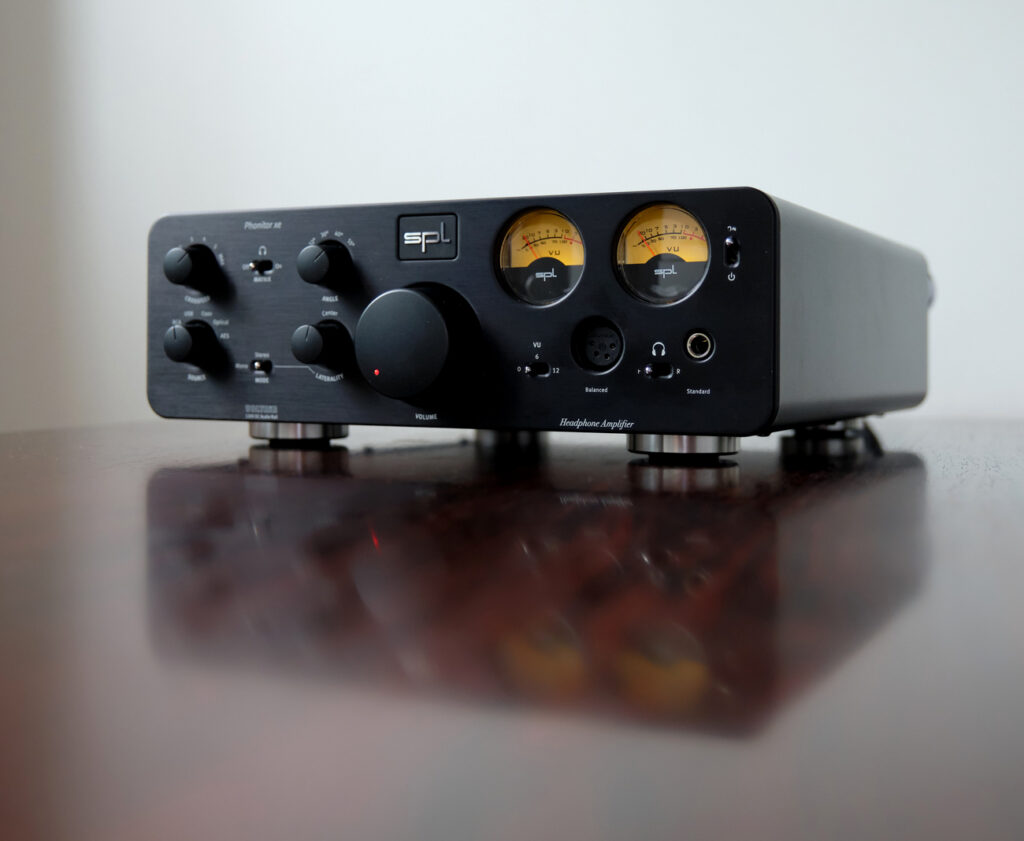
CONCLUSION
The SPL Phonitor xe is a superb headphone amplifier. It is powerful enough to drive the most demanding headphones with authority. It is also silent enough to be used with very sensitive headphones. The unbalanced output is quite capable and has a pleasing sound with a sense of warmth and fullness.
It is, however, in balanced mode, that the Phonitor truly awakens. It sounds powerful and dynamic, clear and transparent – in a very natural and organic sounding way. Simultaneously it has a smooth, sometimes velvet-like tone. It is an amplifier that is impossible to dislike.
With its multiple inputs, outputs and buttons, and especially the excellent sounding crossfeed-matrix, it is a very unique headphone amplifier. The optional DAC768 is excellent and leaves me with no desire for upgrades.
When running the Phonitor xe in balanced mode, the amplifier (which is the same as in the Phonitor e and the x) is truly exceptional. As an all in one solution for headphone listening, the Phonitor xe is the best I have tested.
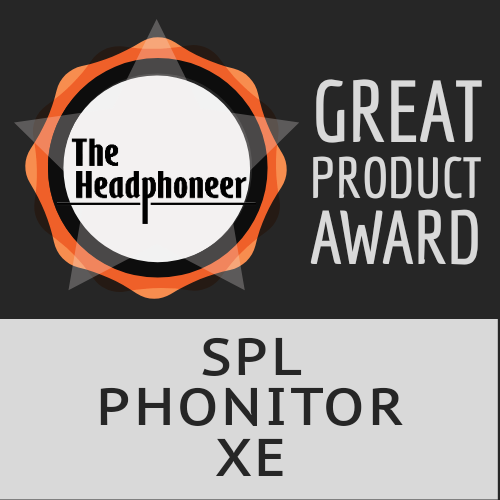
If you enjoyed this article or other content on The Headphoneer, you might consider leaving a small donation to keep this website up and running. No donation is too small. Thanks for supporting us!
If you like our work please follow us on Instagram, Facebook and Twitter , it will help us grow. Sharing is caring 🙂
SELECTED MUSIC
End of the World Party – Medeski, Martin and Wood
Godzilla – Eminem/Juice WRLD
Bing – Sheppard, Paricelli, Aarset
OTL – Little Hurricane
Happens To The Heart – L.Cohen
Clocks – Erlend Dahlen
Hellbound On My Trail – Cassandra Wilson
If You Want It – Jay Som
So In Love – Jakob Brio Trio
Camino Piedroso – Ambrodiva
Carratera – David Brito
Agitation – Finn Peters
Vodoo – Sonny Clark Memorial Quartet
The Judge – Daniel Foose
Chameleon – Trentemøller
Mr.Pants Goes to Hollywood – Marc Ribot´s Ceramic Dogs
The Willie Walk – John Stein Trio
Say Goodbye – Norah Jones
Can´t You See – Susan Wong
Terminal 7 – T.Stanko Quintet
Cards – Roscoe Mitchell Quartet
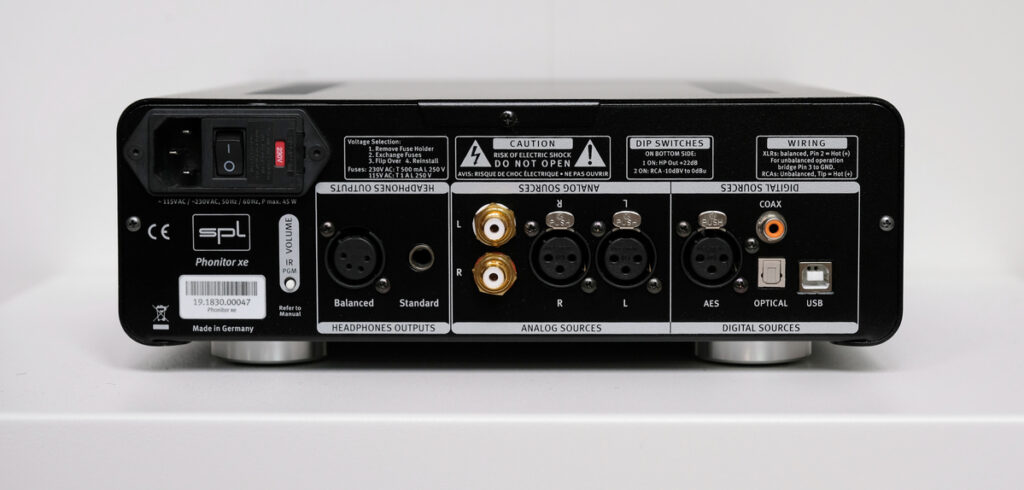
PHONITOR XE SPECIFICATIONS
Balanced Headphone Output
Neutrik 4-pin XLR connector
Pin wiring: 1= L (+), 2= L (-), 3= R (+), 4= R (-)
Impedance: 0.36 ohms
Damping Factor: 180 @ 40 ohms
Frequency Range: 10 Hz to 300 kHz ( -3 dB)
Crosstalk at 1kHz: -90 dB
THD & N: 0.00082 % (at 0 dBu, 1kHz, 100 kohms load)
Noise (A-weighted): -98 dBu
Dynamic Range: 130.5 dB
Unbalanced Headphone Output
6.35 mm TRS connector
Pin wiring: Tip = Left, Ring = Right, Sleeve = GND
Impedance: 0.18 ohm
Attenuation Factor: 180 @ 40 ohms
Frequency Range: 10 Hz to 300 kHz ( -3 dB)
Crosstalk at 1kHz: -90 dB
THD & N: 0.00082% (at 0 dBu, 1 kHz, 100 kohms load)
Noise (A-weighted): -103 dB
Dynamic Range: 135.5 dB
Unbalanced Max. Output Power (at +30 dBu @ 1 kHz)
1 W x 2 at 600 Ohm impedance
2 W x 2 at 300 Ohm impedance
3.7 W x 2 at 120 Ohm impedance
2.9 W x 2 at 47 Ohm impedance
2.7 W x 2 at 32 Ohm impedance
Balanced Max. Output Power
These measurements are not on the website but was sent me by SPL
4.4W x 2 at 600Ω
9W x 2 at 300Ω
7.4W x 2 at 150Ω
6.2W x 2 at 47Ω
Power Supply
Mains voltage (switchable): 230 V AC / 50 Hz or 115 V AC / 60 Hz
Fuses: 230 V: T 500 mA; 115 V: T 1 A
Power consumption: max 40 VA
Stand-by power consumption: 0.7 W
Dimensions (incl. feet) and Weight
278 mm W x 100 mm H x 330mm D
10.95 in W x 3.94 in H x 12.99 in D
11.24 lbs (5,1 kg), unit only
13.78 lbs (6,25 kg), shipping
Internal Operating Voltages
Analog: +/- 60 V
Digital: + 5 V and + 3,3 V (optional DAC768)
https://spl.audio/professional-fidelity/phonitor-xe/?lang=en
This product was kindly lent to The Headphoneer by Moiz.no


